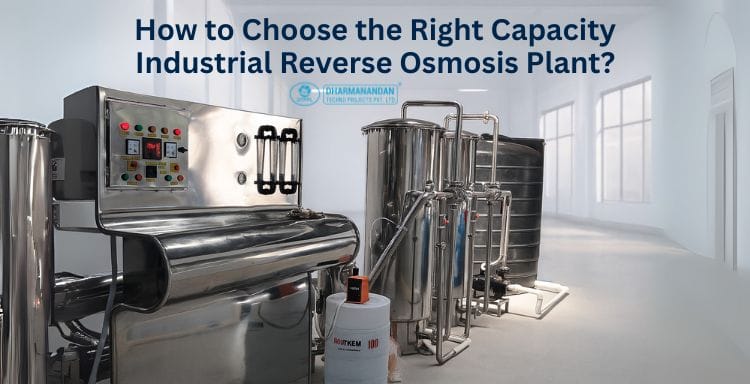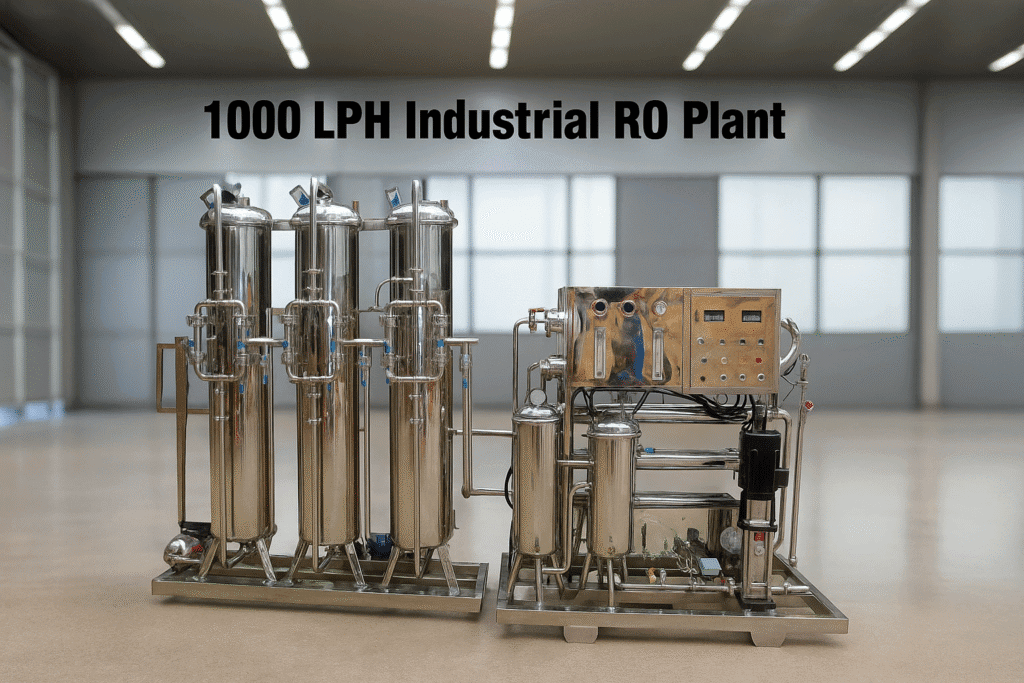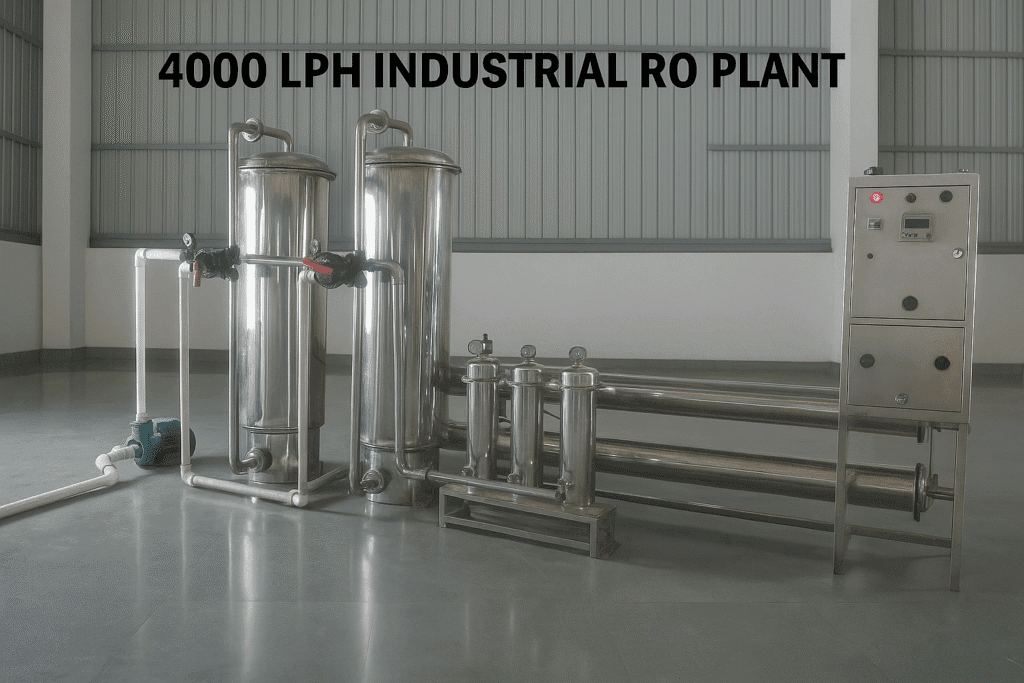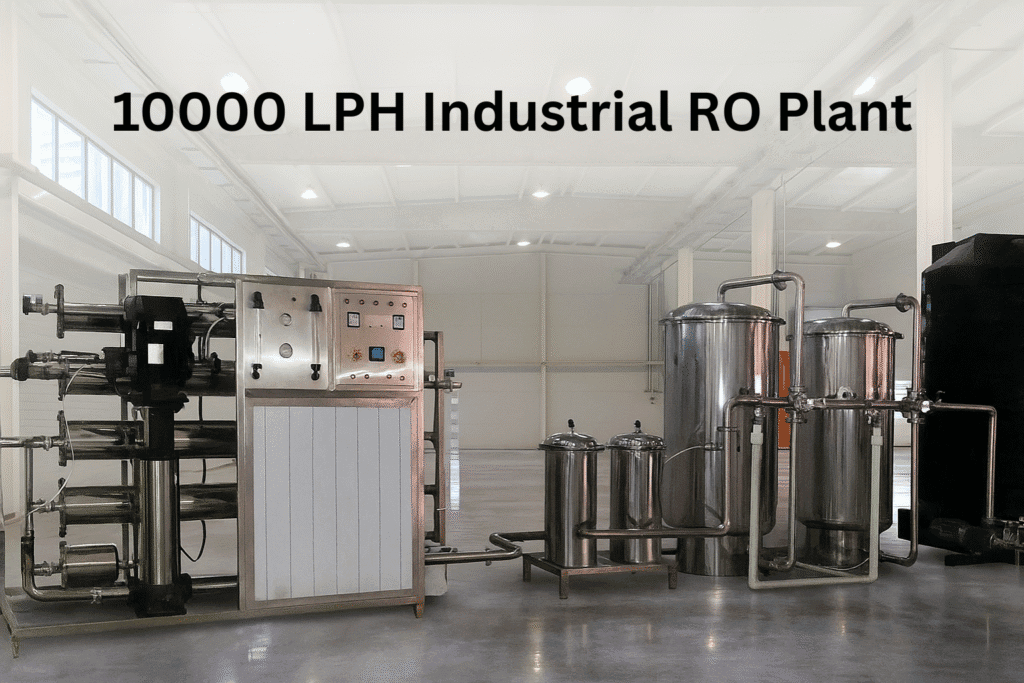
Table of Contents
Industrial Reverse Osmosis Plant: Select the Ideal Capacity for Your Business
September 10, 2025
Industrial Reverse Osmosis (RO) plants have become an essential part of various industries due to their ability to provide purified, clean water, which is crucial for operations and production processes. Whether you’re running a large manufacturing unit, a chemical plant, or a food processing factory, selecting the right capacity RO plant is vital to ensure efficiency, cost-effectiveness, and long-term sustainability.
Industrial RO systems come in different capacities, and choosing the right one depends on factors such as your daily water consumption, the quality of the raw water, the space available, and the type of industry you’re in. This article will guide you through the process of choosing the right capacity Industrial RO plant by exploring various plant capacities such as 1000 LPH, 2000 LPH, 3000 LPH, 4000 LPH, 5000 LPH, 6000 LPH, 8000 LPH, and 10000 LPH, while also categorizing each plant type based on different industry needs.
The Importance of Choosing the Right Capacity Industrial RO Plant
An Industrial Reverse Osmosis system is designed to remove impurities from water through a semi-permeable membrane. The capacity of the RO system determines how much water it can purify in a given period, typically measured in liters per hour (LPH). The capacity of reverse osmosis plant is critical because it directly impacts the operational efficiency, maintenance costs, and energy consumption.
Choosing the correct capacity ensures that your business has access to a constant supply of purified water without over-investing in a system that is too large or experiencing shortages due to an undersized unit. It is important to consider factors such as:
- Daily water consumption
- Peak demand
- Raw water quality
- Space and installation constraints
- Maintenance and operational costs
If any of these factors are overlooked, businesses might either face water shortages or incur unnecessary costs related to energy usage and system maintenance. In this article, we will break down the different capacities and discuss the most suitable industries for each type.
Understanding the Different Capacities of Industrial RO Plants
Below are the common capacities of industrial RO plants, ranging from 1000 LPH to 10,000 LPH, with their respective advantages, limitations, and ideal industries.

1000 LPH Industrial RO Plant – Small to Medium-Scale Operations
- Suitable for: Small to medium-sized manufacturing units, food processing units, pharmaceutical companies, small-scale industrial operations, and commercial complexes.
- Daily output: Approximately 8,000 to 10,000 liters/day.
Advantages:
- Compact design, requiring less space.
- Suitable for operations with moderate water requirements.
- Lower initial investment compared to larger systems.
Limitations:
- Might not be enough for industries with higher water demands during peak production times.
- Requires regular maintenance to ensure efficiency.
Ideal Industries:
- Food & Beverage: Small-scale food production units, coffee factories, or dairy processing plants.
- Pharmaceutical: Small-scale pharmaceutical companies that require purified water for production but do not have large volume demands.
- Manufacturing: Small manufacturing plants, such as garment factories or metal processing units, where water usage is moderate.
2000 LPH Industrial RO Plant – Mid-Scale Operations
- Suitable for: Medium-sized factories, small hospitals, commercial buildings, and restaurants.
- Daily output: Approximately 16,000 to 18,000 liters/day.
Advantages:
- Provides adequate purified water for mid-scale industrial units.
- Suitable for industries where water demand is higher but still limited to specific production schedules.
- Easy to maintain with moderate operational costs.
Limitations:
- May still struggle to meet peak demand in industries with fluctuating water needs.
- Requires additional storage or backup systems for consistent supply during high demand.
Ideal Industries:
- Restaurants & Hotels: Medium-sized restaurants, hotels, and catering services with high daily water consumption.
- Healthcare: Small hospitals or clinics where purified water is essential for daily operations, including surgeries and patient care.
- Packaging & Bottling: Small-scale packaging plants requiring water purification for manufacturing and cleaning processes.
3000 LPH Industrial RO Plant – Larger Manufacturing Units
- Suitable for: Large food processing plants, pharmaceutical industries, and medium-sized textile factories.
- Daily output: Approximately 24,000 to 30,000 liters/day.
Advantages:
- Offers consistent water supply for medium to large-scale operations.
- Can handle moderate to large water consumption, making it a good choice for industries with steady demands.
Limitations:
- Higher energy consumption and operating costs compared to smaller units.
- Requires more space for installation and storage.
Ideal Industries:
- Food & Beverage: Medium-sized bottling or beverage plants, and food processing units.
- Chemical Manufacturing: Chemical plants with moderate water usage requirements.
- Textile Industry: Medium to large-scale textile plants requiring significant amounts of water for dyeing and washing.

4000 LPH Industrial RO Plant – High Demand Operations
- Suitable for: Large-scale manufacturing units, large hospitals, or small industrial complexes.
- Daily output: Approximately 32,000 to 40,000 liters/day.
Advantages:
- Ideal for industries that experience higher and more consistent water demand.
- Efficient system providing adequate purified water even during peak hours.
- Less maintenance required than smaller systems.
Limitations:
- Larger footprint and more complex installation process.
- Increased operational costs (energy consumption and maintenance).
Ideal Industries:
- Hospitals: Large hospitals that need large quantities of purified water for patient care, sterilization, and other medical operations.
- Factories: Large manufacturing plants, including metal fabrication or automobile assembly units, where water consumption is high.
5000 LPH Industrial RO Plant – High-Capacity Industrial Units
- Suitable for: Large factories, large hospitals, commercial buildings, and multi-purpose industrial complexes.
- Daily output: Approximately 40,000 to 50,000 liters/day.
Advantages:
- Excellent choice for high-demand industries.
- Can handle both regular and peak water consumption with ease.
- Provides consistent and reliable water purification.
Limitations:
- Higher initial investment and installation complexity.
- Requires significant space and professional maintenance.
Ideal Industries:
- Pharmaceutical: Large-scale pharmaceutical plants with strict water quality requirements.
- Food Processing: Large food processing or packaging units with high daily water usage.
- Chemical Plants: Chemical manufacturing units requiring continuous purified water for production processes.
Read Our Article: Understanding the Operation of Water Treatment & Reverse Osmosis Plants
6000 LPH Industrial RO Plant – Industrial Grade for Heavy Operations
- Suitable for: Large industrial plants, food production factories, textile mills, and multi-location facilities.
- Daily output: Approximately 48,000 to 60,000 liters/day.
Advantages:
- High output capacity to meet large-scale industrial demands.
- Efficient and continuous water supply for continuous production operations.
- Advanced filtration and purification system for better water quality.
Limitations:
- Significant upfront cost and maintenance requirements.
- Requires skilled personnel for operation and upkeep.
Ideal Industries:
- Textile Industry: Large textile mills requiring vast amounts of water for dyeing, washing, and processing.
- Food & Beverage: Large beverage plants and food manufacturing units with continuous high water consumption.
8000 LPH Industrial RO Plant – Heavy Duty Industrial Needs
- Suitable for: Large-scale manufacturing, power plants, and multi-facility complexes.
- Daily output: Approximately 64,000 to 80,000 liters/day.
Advantages:
- Suitable for industries with continuous, large-scale water needs.
- Provides reliable purification with minimal downtime.
- High-quality output that meets stringent industrial standards.
Limitations:
- Requires significant space, energy, and specialized maintenance.
- High operational costs but cost-effective for large-scale operations.
Ideal Industries:
- Power Plants: Power generation units requiring large volumes of purified water for cooling and operations.
- Large Factories: Automobile factories, petrochemical plants, and other large manufacturing units.

10000 LPH Industrial RO Plant – Large Scale Industrial Applications
- Suitable for: Extremely large industries, commercial complexes, and multi-unit industrial operations.
- Daily output: Approximately 80,000 to 100,000 liters/day.
Advantages:
- Handles massive water demands with ease.
- Suitable for multi-factory operations or industries with continuous large-scale water needs.
- Minimal downtime and reliable output for high-intensity operations.
Limitations:
- Significant installation and operational costs.
- Requires professional maintenance and monitoring.
Ideal Industries:
- Heavy Industry: Large manufacturing units, power plants, or chemical plants that require uninterrupted purified water.
- Multi-Facility Complexes: Large industrial zones, multi-building commercial complexes, or residential communities requiring constant purified water supply.
Factors to Consider When Choosing the Right RO Plant Capacity
Daily Water Consumption
Estimate how much water your operation consumes on a daily basis. This is the first step in selecting the right-sized plant. If your daily consumption exceeds the plant’s capacity, you may face water shortages or the system may overwork, resulting in premature wear and tear.
Quality of Raw Water
The quality of your source water impacts the choice of RO plant. If your raw water has high levels of TDS (Total Dissolved Solids), hardness, or contamination, you may need a larger capacity or additional pre-treatment systems.
Peak Demand
Consider your peak water demand. For industries with fluctuating water usage, such as restaurants or manufacturing plants, it’s essential to have an RO system that can handle surges in demand.
Space Availability
Larger capacity RO plants require more space. Assess whether you have adequate space for installation, including the system, storage tanks, and other associated equipment
Cost Considerations: Cost vs. Capacity
When selecting an RO plant, it’s crucial to balance the cost with capacity. A larger system offers greater water output but comes with higher capital expenditure, operating costs, and maintenance requirements. Conversely, an undersized system might not meet your needs, leading to system inefficiency, breakdowns, and increased operational costs.
Conclusion: Choosing the Right RO Plant Capacity for Your Business
Selecting the right capacity industrial RO plant is critical for ensuring your business runs smoothly without unnecessary expenses. Whether you need a 1000 LPH RO plant for a small manufacturing unit or a 10000 LPH RO plant for large-scale industrial use, it’s essential to assess your water consumption, peak demand, and raw water quality. By choosing the correct capacity, you ensure operational efficiency, cost savings, and a consistent supply of purified water.
FAQs: Industrial Reverse Osmosis Plant
1. How much does an industrial RO plant cost?
The cost varies depending on the capacity, features, and customization. For an accurate quotation, it’s best to contact Dharmanandan Techno Projects Pvt. Ltd. for a detailed assessment and pricing based on your specific needs.
2. Can I scale my RO system as my water needs grow?
Yes, most industrial RO plants are scalable. Additional units or components can be added to increase capacity if your water needs grow.
3. How do I maintain my industrial RO plant?
Regular maintenance includes changing filters, membranes, and servicing pumps. Professional maintenance services are recommended for larger systems.
4. How long do industrial RO plants last?
With proper maintenance, an industrial RO system can last 10-15 years, depending on the quality of the components and the operating environment.
5. What is the energy consumption of industrial RO plants?
The energy consumption depends on the plant size and the water quality. A larger plant will consume more electricity, but newer systems are designed to be more energy-efficient.

Director – Global Marketing and Sales
Mr. Bhavesh from Dharmanandan Techno Projects Pvt. Ltd. has played a pivotal role in elevating the DTPPL brand to the global stage, leveraging his exceptional expertise in marketing and communications. He is committed to helping clients achieve significant growth while strengthening their own brands. Dharmanandan Techno Projects Pvt. Ltd. is a leading manufacturer and supplier of water purification systems and turnkey solutions for mineral water plants. With years of experience in designing and delivering high-quality water treatment solutions, the company provides end-to-end services, including system design, installation, maintenance, and ongoing support. Specializing in scalable and customizable water plants, DTPPL has successfully served industries worldwide, ensuring clean and safe drinking water across diverse applications.
